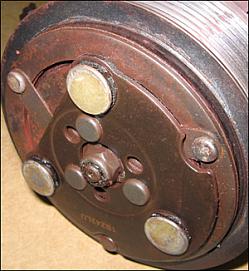
Clutch Slipping is a condition that occurs when the armature plate fails to engage and rotate in synchronization with the clutch rotor. The field coil when energized becomes an electromagnet which then magnetizes the Clutch rotor and Armature plate. Friction and magnetic attraction cause the Armature plate and Clutch rotor to lock together (clutch engagement) and rotate the compressor shaft.
Clutch Slipping specifically refers to a situation that occurs when the armature plate fails to lock together properly with the rotor. The armature will then tend to drag (slip) against the rotor surface. This dragging (slipping) results in intense friction and heat. As the slipping continues, the heat causes deformation of the armature plate. In the case of a rubber armature, clutch slipping may lead to melting of the rubber damper and can result in a subsequent failure of the entire clutch mechanism.
Possible Causes of Clutch Slipping and overheating:

